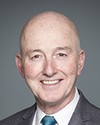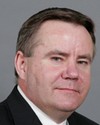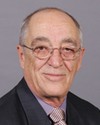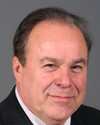Mr. Chairman, members of the committee, good afternoon.
My name is Linda Fischetti. I'm going to be talking about two programs and one workforce issue. “My HealtheVet” is a personal health record that we offer to our veterans. We also have an interoperability program with the Department of Defense, which I'll mention. I'll also speak to the informatics workforce.
My HealtheVet is a personal health record. It is accessible to the veterans from home. There is a three-tiered level of access to this. The first tier is that anyone can go and look at a limited amount of information online.
The second tier of access is that a veteran will go in and register himself or herself, and at that point in time the veteran is able to see information that is educational and targeted directly to our veterans. This information has been vetted by a content-matter expert team of both clinicians and other veterans, so we're making sure that the veterans are receiving information from trusted sources to educate them about their health care issues.
The third level of access is that a veteran can choose to go to a local VA medical centre and, through the health information management professional, be in-person authenticated. At the point in time that a veteran is in-person authenticated, they are then able to actually import information from our electronic health record, which Ms. Graham just spoke about, into the personal health record.
We're rolling out at a number of sites. We have not completed our national rollout. That will be finished by the end of this year.
The feedback we've received from the veterans on this ability to import their own electronic health record information is very empowering. They feel that they're able to be more of a partner in their care. They're also able to journal their own information. For example, they can import information from the electronic health record related to lab results, and then, on the other hand, journal some of the personal choices, lifestyle choices, that might influence those lab results. Therefore, they'd be able to see a trend in their personal journal of salt intake and weight changes related to blood pressures that were recorded when they were at the medical centre at their different visits. So we partner with our veterans for this ability to give them their own personal health record.
Our typical veteran who chooses to participate is a Vietnam War veteran who is between 51 and 70 years old, actually changing the paradigm of the assumption that it's the younger generation that has a greater affinity for IT.
The frequency at which this veteran comes and visits us is about once a month. The reason for this is that the veterans who choose to use the personal health record are able to reorder their prescriptions online. No longer do they have to go into the medical centre or pick up the phone and call someone during the times they're open and reorder their medicine, in person or by phone. They're able to go online and reorder their medicines. We believe this is what drives the majority of our veterans coming in once a month.
We currently have 590,000 users, who have racked up 18 million visits, and we have refilled six million prescriptions. We have found also that as we bring new functionality online, the number of people who participate in the use of it increases.
One of the things we also do is use a web survey tool, called the American consumer satisfaction index, to make sure that we are capturing veterans' level of confidence in the information on the website and their opinion on the look and feel of the website. As well, we ask them what future functionality they would like us to put into the personal health record. Based on this, we're able to prioritize our future development efforts.
We know, for example, that the very next thing the veterans would like to see are all of their upcoming appointments. We know this because we asked them in this web-based survey that takes place when they're in the personal health record online, at which point in time we can float that to the top of our development priority.
The next program that I want to speak about is the interoperability that we have with the Department of Defense. There are different levels of interoperability. For example, you can just move text from one electronic health record system to another in such a way that the text is then displayed to the clinician. It's human-readable text. You're not able to sort it or parse it or to compute any logic against it, such as with clinical reminders. We have that as our first effort of interoperability.
The second level of interoperability is the ability to recognize that different parts of the electronic health information coming from a foreign electronic health record is in fact a lab value, or a pharmacy order, or a progress note that has been entered by a clinician, at which point in time you're able to put those appropriately where they belong within your electronic health record.
The highest level of interoperability that we're speaking about today has to do with information that's semantically interoperable, against which in fact you would be able to do pharmacy checks.
Within our DOD-VA interoperability, we started with the first type, the ability to just view the information from DOD in 2002. At this point in time, we have moved information on four million patients from DOD over to VA. This is a one-way interface called a federal health information exchange. It is only the big chunk of human-readable text information that comes across at the lower level of interoperability.
As our systems have become more sophisticated, we have been able to move information in both directions--from VA over to DOD and from DOD over to VA--and we're able to do this in real time, at the time the clinician asks for it. We've been able to move approximately three million patients' records this way. This information is also sorted. We call this our bidirectional health information exchange.
In response to the severely wounded warriors, since the beginning of the current engagement we have realized the value of moving all of the veterans information that has been collected at every point at which they've been seen within DOD. So not only the lab results but also the X-rays and the pathology results, and everything related to the patients who are severely wounded, needs to be moved into the VA polytrauma centres. With that, we were able to quickly set up an exchange that involved collecting and moving all of that information to a single point.
We continue to explore the highest level of interoperability in a project that we call the clinical health data repository. With that, we have mapped common terms for pharmacies, allergies, and a few other domains so that we are able to actually do an order check to see, for example, if two orders have been written for the same medication.
Lastly, I want to talk about a workforce issue. You've heard a great deal from Ms. Graham in terms of the use of IT within the health environment. What VA has done is impressive. The level of saturation at which clinical and business processes within the health care environment are supported by IT is pretty unprecedented, when you look at our size and the number of processes we support.
Yes, this is an IT issue in terms of how we protect the information, keep it secure, and move it to wherever the patient is and where the clinicians need that information, but there is also a culture change. So we work with a workforce called “informaticists”. Informaticists are a group of people who focus specifically on the area between the IT domain knowledge and the clinical domain knowledge.
These are people who work on things such as what I just spoke about--semantic interoperability. How do you make systems sophisticated enough and normalize the information to the point that you can do this? It takes a great deal of effort. How do you take IT and insert it into a physician's process of writing an order and do it in a way that's effective so that the physician will continue to use the IT and actually feel a level of trust and safety that in fact there's a value added in having the IT there?
Within our environment operationally, informaticists are at the elbow of the clinicians who are using the system. They're also involved in system development. In fact, with the system development, they continue to work with the development teams to give iterative direction. For example, if you display a serum sodium that way, the clinician is not going to know what it means. A software developer would not know that. The clinician and the informaticist at the elbow of the software developer can help improve product that comes out.
In terms of research, we have a large research community here within the veterans health administration. We partner with them to do things such as human factors engineering software before it's put into the clinical space, or look at whether we have in fact improved clinical outcome with the insertion of a new technology into the health care environment.
Very important is the health information management professional. One of the most important things when you are moving from the paper record and you're changing the media of that health record to now become an electronic record is to preserve all of the policies and guidelines that have been in place to assure the integrity and legal accountability of that paper record. The health information management professional is the one who has to rewrite all of the policies or continue to enforce the policy and is a very important check-off for any IT that's going out into the clinical space to make sure that in fact you're capturing information that will have the integrity of the previous paper medical record.
That ends my comments. I'm going to hand it back to Susan.







